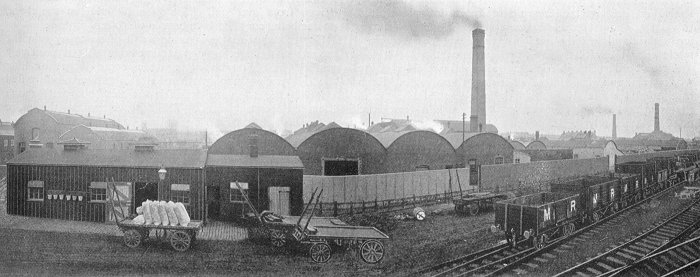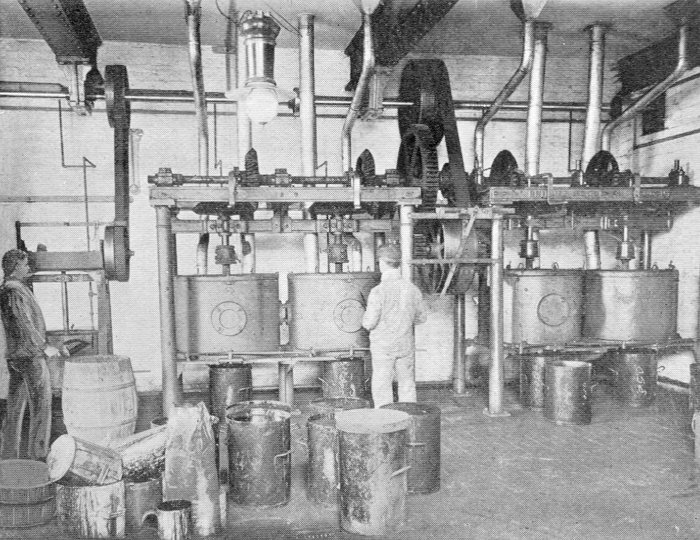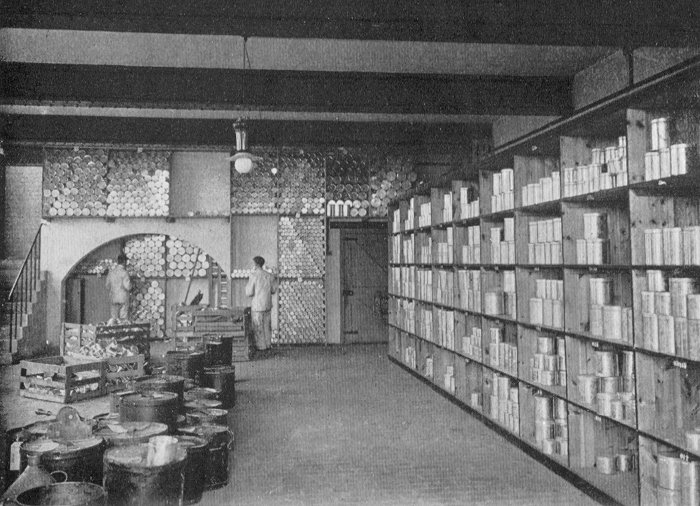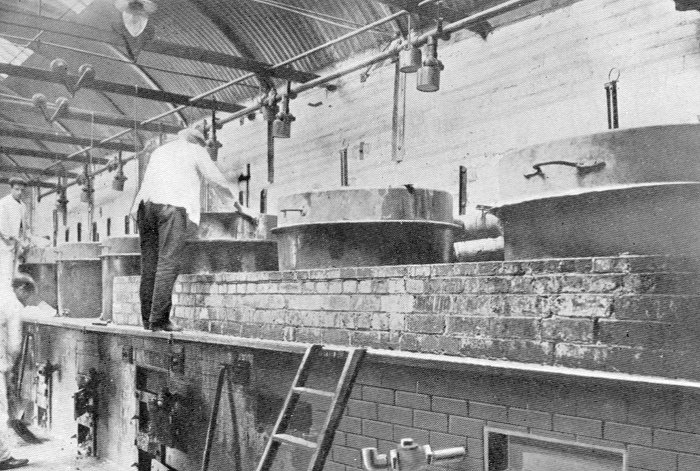|
From the December 1908 edition of
'The British Printer':
With the Ink Makers. Manders' New Auxiliary Works
As further testifying to the remarkably strong
position attained by the house of Mander-not merely in respect
to varnishes, colours and paints, in all of which directions its
output is of huge proportions, but more particularly in the
printing ink section and its essentials in respect to colour,
varnish and so on-have we pleasure in placing on record some
impressions of the establishment gleaned during a visit early in
November last.

Wednesfield Works in 1908.
The headquarters and chief works are situated
round and about St. Johns Street, Wolverhampton, but out at
Wednesfield, some two or three miles away, is situated a further
large establishment, in itself much larger than most factories
associated with the allied industries. To refresh our memories
in respect to colour, we look in at the Town Well and School
Street Works paying special attention to the department 'devoted
to colour making. These show open, single-story rooms with
gallery, enormous vats at one end, and a long row of huge tanks
of colourful length of the floor.
After filtering, tramlines
bear the trucks carrying the colour into steam-heated or
vacuum chambers. The lighter colours, the deeper lakes,
and the darker shades are confined to their respective
departments, and it is very interesting to note how,
after mixing, the development of colours is succeeded by
unnumbered washings of pure water, whilst from beginning
to end is felt the control exercised by the laboratory.

Black Ink Mixing.
The chemists' department
seems to us to be one of the most striking features of
these works.
It controls test by test, all supplies of
goods coming into the works, all results obtained at the
various stages of manufacture, warrants the sale of the
finished article, whilst, above and beyond this, it is
constantly at work on new colours, colour combinations,
new methods of treating colours and oils, of suiting
inks to papers.

The Ink Grinding
Department. The permanency of colour seems to be an ever
present aim, and, walking out on to the flat roof facing the
laboratory windows, we notice many slips of paper attached to
the windows, all bearing colours under test in some degree for
permanence in connection with atmospheric effects. Some of the
slips are dated nine and twelve months ago.
The Wednesfield Works
On the outskirts of Wednesfield a seven-acre
piece of land, bordered by canal on one side and railway on the
other, easily reached also by the electrical tramway, is the
property of Messrs. Mander Bros., and a very considerable area
of ground is covered by various specially-erected buildings. We
find that since our visit of some years ago the buildings have
been entirely re-modelled and large new departments added. The
firm is in the enviable position of possessing ample
accommodation to carry out its own ideas in respect to the most
desirable arrangement of works, and we are to find that the aims
and ideas of experts have been actually carried out here. The
premises are regarded as the ideal of their class.

The Colour Mixing Room.
The main buildings run
along the water-side, with others at right angles. The
first are devoted to colour mixing and to ink making, in
fact, forming an ink making plant complete; the other
series of buildings nearer the railway is allotted to
varnish manufacture, also complete. These works are, we
understand, chiefly used for supplying the materials
made up at the Wolverhampton departments.
A tree-bordered main road sweeps
round two sides of the works area, and affords access for vans
to all parts. Each of the buildings is allowed ample space round
about, and the structures, more particularly the new ink works,
are most substantially built, with stone staircases, concrete
floors, and fireproof generally.
The electric light is used
throughout, and, as at the Wolverhampton works, a
marvellous degree of cleanliness and tidiness prevails,
for although all departments are evidently very busy,
untidiness is never apparent, and many a printing office
with far less excuse for the appearance of its rooms
might take a lesson from the ink maker.
The general scheme with regard to
these works seems to be the elimination of dry colour from the
grinding rooms, realizing that dust floating in the air and
being deposited on grinding rollers may seriously neutralize the
efforts to provide thoroughly pure and finely-ground colour.
Thus a long room is devoted entirely to ink grinding, a heavy
door shutting off the ink-mixing department with its closed-up
machinery. Printers will appreciate this point.
A low screen across the centre with the driving motors to left
and right divides the floor area. Around and against the walls,
with ample space about, is arranged a continuous series of large
three-cylindered ink-grinding machines, a battery of some
five-and-twenty of large size being already in full operation.

The Can and Drum Store.
It is interesting to go from
machine to machine and to note well-known colours in soft,
oily curves rolling away from the pressure of the cylinders,
the white coated operators, each with his magic broad-bladed
knife charming or threatening-whichever you like his machine
into uniform pressure and even flow. Well-known blacks,
blues, and greens in one section are shown as on regular
order for well-known magazines, whilst other colours are
equally popular for illustrated work.
The facility for handling
cans, for frequent tests and arrangement
generally, speak of an ideal system. Driving is obtained by short
belts driven from overhead shaft on either side of the room,
power being supplied by a couple of 50h.p. motors.
Contrasted with the roar and roll
of so many grinding machines, the mixing department alongside is
positively restful. Judging by the piping which comes from the
ceiling the tall mixing machines are fed from above, and we find
this to be the case, varnish and dry colours being fed through
their respective channels. This further explains the entire
absence of dust, that is dry colour, in the air. The mixers are
mechanically operated, the cleverly arranged blades of the
paddle mixers making short work of the compounds of oil and
colour. Besides the series of large sizes there are smaller
cylindrical mixers, and we note particularly the curious looking
litho blacks in their steam-heated pans. This department is
devoted to blacks.
Colours
In the next building across the yard is a department much
more pictorial in effect. Again carrying out the idea of freedom
from dry colour or dust, this room is fitted down one side and
the centre with a series of bins with closely fitting lids. In
these bins dry colours are stored, and the effect is to keep one
colour to itself when the supply is being drawn upon, for, of
course, neighbouring stocks would not be opened at one and the
same time. Along the further side of the wall is a series of
mixers, and we find these to embody some very ingenious ideas in
apparatus for mixing. There are small-sized circular mixers
ready to tackle small quantities of special colour fitted with
scientifically arranged knives which scrape the sides, vessel
and knives being revolved separately. To complete this as a
mixing department, on a third side is a row of varnish tanks
holding the pale, transparent varnish used for mixing colour.
This department, as with the others, is self-contained, and
possesses its own motor for driving purposes.

The Varnish Boiling Works.
Stores
Stepping now into a large roomy
building, shelved from floor to ceiling along the walls, and
with tables and benches, we find a can and drum store. The
familiar tins in a variety of sizes are arranged in their
respective sections, and all readily accessible. This is not a
tin store, but an ink warehouse, and in spite of the chief
chemist's confidence as to the absolute uniformity of new inks
and those made for some time, it is quite clear that he makes no
mistake as to keeping up substantial stocks of all colours. This
we are glad to see, for we know only too well how commercial
conditions so frequently require the printer to order inks for
immediate use. Here once again we have the assurance that the
laboratory maintains rigid fulfilment to standards, so that
absolute reliance may be placed on receiving the same colour at
any time of ordering.
The floor above is used as a
storeroom for important sundries such as pomade and
ink-easers. A steam-heated pan for solidifying oil is also
noticed, the odour of the place being rather pleasant than
otherwise. On looking out from the crane platform at the far
end a fine view of the edge-bordered fields is obtained, for
we are really on the fringe of the country here, with all
the real country advantages of fresh air and spaciousness
generally.
An adjacent room, the dry black
room, is situated directly over the black mixers, to which
earlier reference is made. The whitewashed walls are rapidly
assuming the artistic mottled effect of a busy chimneysweep's
countenance through contact with the piled-up sacks of carbon
blacks lodged here. The receptacles over the mixing cylinders
are filled from here, and again there is every facility for
minimizing any waste and preventing dust and trouble resulting
there from.
The isolation of blocks of
buildings is carried out with a thoroughness which must be the
envy of those confined within small and often cramped areas. To
reach the place of storage where the casks of colour, tins, and
supplies of this character are safely put out of the way, and
yet easy of access, we cross the yard again and enter a long
single story building filled with casks and crates, tins and
drums.
The Varnish Side
In totally distinct buildings,
separated by considerable yard space, is carried on the
operations concerned with varnish making. First to the actual
cooking. Without referring to the varnish
works in detail, as this department represents rather a
re-organized section than a new works, we may refer to some
impressions gained whilst witnessing the various operations of
manufacture. The varnish-boiling works show a long row of pans
set in brick with closed fires. A large cowl or hood is
fitted to each to carry off fumes, and conspicuously
placed thermometers record temperatures.
|

From the 'British Printer',
November 1939. |
Conscientiously
climbing the steps to sniff at the odours each successive one
surely more pungent than its predecessor we are able to note the
great heat used, and to observe the working generally, returning
with an enhanced impression of the infinite care taken to
prepare varnish.
At the rear of this building is
one of similar size, the tubing whence escapes the fumes from
the pans being here in evidence, and we are shown a clever
device automatically coming into operation at each pan in case
of fire from any individual boiler.
Following the varnish as it
runs off in pipes across the yard to the oil stores, we find on
the second floor of a substantial building several dozen
thousand gallon tanks, each equipped with gauge for showing
depth of varnish contained in the tall cylinders, and with pump
for filling or removal of the contents. Large as would appear to
be this stock, as we are aware from visits to varnish stores,
this represents but a fraction of the tremendous amount of oil
always maturing in the firm's stores. |
Fire Fighting
The various buildings are
disconnected, partly for convenience for manufacturing purposes
and largely to minimise the risk of and the scope of damage by
fire. Expecting to find full provision made to meet emergencies,
for the fire fiend is ever a possible foe where oils are being
treated, we found that every possible safeguard was adopted and
each section provided with appliances for fighting that which is
a good servant but a bad master. The works also possess their
own fire brigade-already tried once on their own area and again
at a neighbouring concern. Whilst we were present an alarm was
raised and instantly men swarmed out of the buildings, each to
his allotted task seizing section after section of hose pipe,
bucket, or "stood by" hydrants exactly where duty required, and
all with a celerity which it would be difficult to surpass.
The District
would appear decidedly popular
with the workpeople, and so healthy as to form quite a
sanatorium for those employed at headquarters. Leaving the works we are struck
by the appearance of a fine new building, an attractively built
school in style, with a handsome villa attached.
Inquiry as to
this led to the production of keys, the opening of doors, and we
found the building to be a messroom for the workpeople. The
floor is coated with a special linoleum-like terracotta coloured
concrete, warm and clean in appearance. The tables and seats are
painted a pleasant green and with the large cloakroom and
lavatory make up an eminently neat and attractive picture.
To Sum Up
We come away with the impression
that "this is surely Mander-like" - well thought out, well
carried out, sound in conception, finished in every detail. No
wonder the house maintains its place in the confidence of
friends and customers. |